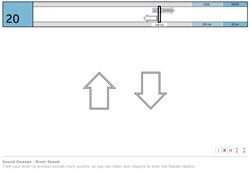![]() Our auditory exercise Sound Sweeps is designed to challenge your brain to speed up and sharpen listening accuracy. The brain can only record sounds (and ultimately recall them) accurately when it is able to hear those sounds clearly and quickly.
Our auditory exercise Sound Sweeps is designed to challenge your brain to speed up and sharpen listening accuracy. The brain can only record sounds (and ultimately recall them) accurately when it is able to hear those sounds clearly and quickly.

In our Sound Sweeps exercise you will listen to frequency sweeps and identify whether the sweeps begin low and rise upward (‘weep’) or if they begin high and fall downward (‘woop’). Of course, you may be wondering what this type of brain exercise has to do with helping you in the real world.
In order to understand speech it is essential that our brains can immediately differentiate frequency sweeps. When we listen to an individual talking we may not be consciously aware of these sweeps but many sounds common in speech such as /t/, /d/, /k/,/g/, /p/ are actually made up of a series of sweeps similar to the ones in our Sound Sweeps exercise. In order to understand what an individual is actually saying our brains need to be able to identify these sweeps.
Consider the words “dawn” and “gone” or “bid” and “big” or “muddy” and “muggy” – only one sweep actually differentiates the /g/ from the /d/ in order for the brain to tell these words apart.
The major distinguishing feature between the /g/ and the /d/ sounds is in the top horizontal line. The /g/ illustrates a band of frequencies that are sweeping upwards while the /d/ illustrates a band of frequencies sweeping downwards.

Our brain only has mere milliseconds to correctly identify these frequency sweeps and the sound, word, and sentence they’re part of. However, our brains tend to slow down as we age or if we experience certain types of cognitive conditions. As such, it gets harder to identify these frequency sweeps quickly and accurately which results in an increasing difficulty at distinguishing different sounds.
Often, our loss in ability to distinguish different sounds can be partly compensated for by considering context. As an example, although you might have difficulty distinguishing the difference between the words dad and bad, you won’t necessarily need to distinguish the first sound of the word (/b/ or /d/) preciously when they are included in the sentences “My dad is a happy guy” or “He’s having a really bad day”. Through context we can almost immediately determine what sound we heard based on the sentence’s context as well as other sounds included in each word. The reality is that you may not even notice you were having difficulty distinguishing the word dad from bad.
However, the brain still created a fuzzy recording of the word dad or bad which creates an unfortunate consequence for your memory. When you attempt to recall the word from your memory it will be unclear and surrounded by static.
Over time you can even be impacted in the midst of a conversation if your brain is unable to quickly recognize frequency sweeps. As your brain connections fade it may also become more difficult to recognize the other words in the sentence – words that previously provided you with the context to understand. For example, if the words ‘big guy’ begin to sound muddy then you will no longer be certain if you heard ‘big guy’, ‘big pie’, ‘good buy’ or something entirely different. Being able to use context in order to understand the first half of a sentence becomes more and more difficult. Of course, this becomes even more challenging if the person speaking is a fast-talker, a mumbler, a quiet talker or someone who is generally not clear when he or she speaks.
You’ll know you are experiencing these symptoms if you find yourself constantly asking “what?” or if you find it easier just to nod and smile when you can’t understand what someone is saying to you.
Our Sound Sweeps exercise is designed to solve this problem. In order to help you easily understand what is being said and to create crystal-clear memories the exercise retrains your brain to quickly and accurately recognize frequency sweeps by challenging you to identify sweeps spaced at different intervals and a variety of different frequencies.
As you progress through the exercise it will change in a variety of ways:
- The sweeps will change in frequency with some sweeps sounding high and others sounding low in order to mimic the most common frequency sweeps found in human speech (between 500 and 5000 Hz).
- The Inter-stimulus Interval (ISI) between the two sweeps will become shorter which increases the difficulty.
Our Sound Sweeps exercise changes ISI (sound gap) to help your brain process even those sounds that are particularly close together. This is important because, as the brain slows, it may experience a problem where a second sound immediately following on the heels of a first sound causes interference in the brain known as “Backward Masking” – your brain is still trying to identify the first sound when the second sound has already arrived.
Sound Sweeps helps speed up the brain to overcome this problem by pushing your brain to hear accurately with shorter ISIs. As you improve at identifying the frequency sweeps the sweeps will get faster in order to ensure your brain is constantly challenged.






 English
English
 Français
Français


